#Portuguese architecture by period
Text
Day 14 - Rio de Janeiro
We head to the Centro area today using the metro for a walking tour. It’s a little surprising when getting there at how run down all of the buildings look. Our guide takes us on the three hour tour but within 10mins of starting we stop at a cafe for a break and we wonder if they are scraping the bottom of the barrel for how to fill the time. Anyway eventually we do see some beautiful colonial architecture. However, it’s all been heritage listed and yet a lot of it is falling into bad disrepair. Our guide explains that developers are starting to build skyscrapers behind them whilst preserving the facade only. We hear about how the Prince (pseudo King because his mother the Queen had schizophrenia and was unable to rule) and the rest of the Royal family moved to Brazil for a period during the 1807 just before Napoleon invaded Portugal. As a way of thanking Great Britain for their assistance in the passage over to Brazil the King opened up the ports of Brazil to foreign trade - a huge win for Britain.
It’s really hot today - the digital displays around the city are showing 36° which is high given it’s not summer. We end up at the Lapa stairs - a famous spot in Rio. I’ve read that Lapa is not particularly safe and our guide explained that it’s safer at night because there are a lot more people around because it’s the nightlife area of the city. Our only bad encounter was someone yelling at the tour group and trying to grab someone as they passed. We snap a few pics and move on.





After the tour we try out a Kilo restaurant. It’s a common thing in Brazil where there is buffet foods and you can serve yourself and pay by the weight of your plate. We both had lots of nice food for approx. $10 but we of course went back for a dessert plate too.
The intention was to go back to the apartment but time is running out and Rio traffic is hectic so straight to Sugarloaf Mountain (Pão de Açúcar) it is. We have bought some (quite expensive) fast pass tickets to try and cut out some of the waiting around. We Metro and then Uber over and head up the cable cars to catch the sunset from the top. There are two different cable cars to get upto the top. After the first one we spot a marmoset - Jack LOVES them so we spend a while taking photos of the little cutie. At the top we stop at the bar and try our first Caipirinha. I can’t believe we’ve been here for 5 nights and this is the first one we are trying. It’s so delicious - a bit like a cross between a mojito and a margarita.


From the bar we watch the sunset over Copacabana (plus a proposal on a nearby table) - it’s such a beautiful spot.
Time to Uber home, where we grab a pizza from Zona Sul to cook at home. It’s super thin and crispy so not that filling but it’s nice. This leaves room for more Portuguese tarts from yesterday.
4 notes
·
View notes
Note
11, 14 and 22
:)
11. Something you want to do again next year?
That is a tough question, to be brutally honest. Because 2022, as a year, was a mixed bag, full of frustrating periods, sad events, moments of sheer bad luck (December, I am talking to you!), and two extremely positive highs: the death of my long-lasting depression, and the beginning of my PhD. While many of the bad events can happen again, the same cannot be said about the good things that happened in 2022 - both are strictly one-offs.
So, 2022 was an end-of-the-cycle year. 2023 will be a completely different year for me - for the best or for the worst, it will be nothing like 2022.
So, my choice to answer you will be very simple: in 2022, I want YOU to keep on sending me asks (or any form of interaction you like).
14.Favorite book you read this year?
In 2022, my recreative readings were not exactly stellar. So, my favourite books ended up being academic readings. Please, allow me to choose not one, but three books.
Two of my favourite books were both from a Brazilian author called Ailton Krenak: Ideas to Postpone the End of the World (“Ideias Para Adiar o Fim do Mundo”, in Portuguese) and Life is Not Useful (“A Vida Não é Útil”). Both of them are brilliant perspectives of how ridiculous the Capitalist Society is and how absurd is the existence (life?) of the so-called White Man.
My other choice is a 1958 book from a French philosopher called Gaston Bachelard. The Poetics of Space (“La Poétique de l'Espace”, in French) may be considered an architecture book, but it completely changed my life when it allowed me to understand many of my past decisions - decisions that, until I read this book, I had regrated bitterly. Now, I know what I did and why I did it.
22.Favorite place you visited this year?
I guess the selection of places I visited this year is a tad poor. But there are two places that come to my mind.
One of them is the Castle of Miraflores, in Spain (more specifically, in Extremadura). I had already drove on that road several times, and each time I did it, I always felt the urge to visit that castle on the top of a solitary hill just outside the village of Alconchel. Last August, that finally happened. The castle itself is not spectacular (the restoration works were done with less care than that monument deserved), but the views from the top of the hill certainly are quite something.
My other choice is… well, peculiar. Most people will not understand this one, but you will. I always wanted to visit the exact place in the South Bank of Tagus where the river meets the Atlantic Ocean. And that means I always wanted to visit the Cova do Vapor. And, to be honest, I liked the Cova do Vapor. It's a mix of many things, but it's a very interesting place - and I loved taking photos of the sea hitting the rocks of the pontoon.
Thank you very much for the asks, and sorry for the delay - lately, I am falling asleep much, much, much earlier than I used to. Anyway, may your 2023 be loaded with wonderful things - may the new year be an extremely happy one :)
10 notes
·
View notes
Text

I'm doing a piece that has Ritowa using Riku new ship to go to Braga Portugal to see Bom Jesus Do Monte as a reference to them talking on Forrbidden Fruit as well as historically accurate to the times Portugal was the only ones doing trade with Japan in 1560s.
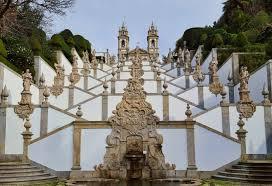
Bam Jesus Do Monte in Br a ga Portugal above.

Dom Jessus Do Monte is one of the oldest Architectural Landmarks for the faith of Christianity.
I thought it be appropriate for them to go to Braga Portugal as it has sever church of historic landmarks dating back to the 16th century and Portugal was the only ones Doing trade at the time.
The crazy part of it is the daimyo that started it was the father to the vessel of Naraku Kagawaki.

Who ironically is the father Kagawaki who is Naraku vessel that he kills when killing Sango family threw Kohaku.

Sumitada is famously known for being the first daimyo to convert to Christianity following the arrival of the Jesuit missionaries in the middle of the 16th century.
As it is a different daimyo then the one they mention in the Series I'd say he's the new one after the Yashahime one dies in 1565

Yes this is the guy that start proper trade in Japan with Portugal.
After being baptized Sumitada became known as “Dom Bartolomeu” and the lord who opened the port of Nagasaki to foreign trade.
This interesting as it is the same time period tht Towa Moroha and Setsuna would live in Fuedal Japan.
Opening he port of Nagasaki helped in dramatically increasing the trade relations of the Portuguese between Japan for over three decades. The Portuguese would even further the depth of its foothold on the port of Nagasaki after assisting

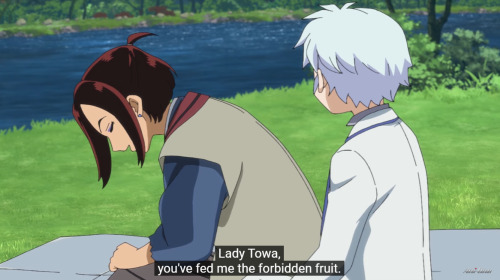


Which it's all pretty funny since literally upon meeting the first thing he dies us get her arrested.
TBC
#zero kirinmaru#christian faith#bom jesus do monte#braga#portugal#Nagasaki hitomi#yashahime#half demon princess yashahime#hanyo no yashahime#towa#ritowa#apple#kagawaki hitomi#naraku
2 notes
·
View notes
Text
Explaining one of VTMB paintings (pt 9)

Cain Killing Abel oil on canvas (Second quarter of 17th century) by Pietro Novelli
Pietro Novelli (March 2, 1603 – August 27, 1647) was an Italian painter of the Baroque period, active mainly in Palermo. He was born in Monreale, and died in Palermo. He initially trained with his father, a painter and mosaicist. His father died in 1625 from the bubonic plague.[2]As a young apprentice he was a fellow pupil with Gerardo Asturino.[3] In 1618, he moved to Palermo and apprenticed with Vito Carrera (1555–1623). His first dated work is from 1626: St. Anthony Abbot for the church of Sant'Antonio Abate in Palermo. The development of his style owed much to Anthony van Dyck, who visited Sicily in 1624 and whose altarpiece, the Madonna of the Rosary in the oratory of Santa Maria del Rosario in Palermo was highly influential for local artists. He was also commissioned works and paintings for many churches in Piana degli Albanesi, and various works to adorn the villas of the Sicilian nobility. Other influences on Novelli were the Caravaggisti or tenebrists active in Naples (for example, Ribera). Novelli also painted for the church of Santa Zita in Monreale, and painted a Marriage of Cana for the refectory of the Benedictines in Monreale.He was injured during the revolution in Palermo in 1647, and died from his wounds.[4] His pupils included Andrea Carreca, Francesco Maggiotto, Francesco Giselli, Michele Blasco, Vincenzo Marchese, Giacomo lo Verde, and Macri da Girgenti. He was also an architect and stage set designer. [1]
The term Baroque probably ultimately derived from the Italian word barocco, which philosophers used during the Middle Ages to describe an obstacle in schematic logic. Subsequently the word came to denote any contorted idea or involuted process of thought. Another possible source is the Portuguese word barroco (Spanish barrueco), used to describe an irregular or imperfectly shaped pearl, and this usage still survives in the jeweler’s term baroque pearl. Baroque art and architecture refers to the visual arts and building design and construction produced during the era in the history of Western art that roughly coincides with the 17th century. The earliest manifestations, which occurred in Italy, date from the latter decades of the 16th century, while in some regions, notably Germany and colonial South America, certain culminating achievements of Baroque did not occur until the 18th century. The work that distinguishes the Baroque period is stylistically complex, even contradictory. In general, however, the desire to evoke emotional states by appealing to the senses, often in dramatic ways, underlies its manifestations. Some of the qualities most frequently associated with the Baroque are grandeur, sensuous richness, drama, vitality, movement, tension, emotional exuberance, and a tendency to blur distinctions between the various arts. [2]
Below is an explanation of the Cain and Able story from real life and in the context of VTM. This is the same for all the Explained Cain slaying Able paintings in VTMB posts I’ve done so feel free to skip if you’ve already read this as it’s long.
___________________________________________________________
The tale of Cain murdering his brother Able are nearly identical in Jewish, Christian and Islamic texts with the oldest known version coming from the Dead Sea Scroll from the first century BCE. Cain was the the first born son of Adam and Eve and became a Farmer while Able was the second born son and became a shepherd. Both brothers made sacrifices to God, but God favored Abel's sacrifice instead of Cain's. In Islam the reason for their offerings is to decide which brother would marry Adam and Even’s first daughter who was also Cain’s twin sister. Able also had a twin sister and Adam wanted the brothers to marry the others twin. In multiple religions each brother has a twin sister but there is no consistently with the names as Cain’s twin sister being named Aclima, Kalmana, Lusia, Cainan, Luluwa, or Awan, and Able’s twin sister is named Jumella, Balbira or to make it more confusing Aclima (though even when she is called this Able’s twin sister is never the one the brothers are competing to marry) depending on the source. In the Islamic text Able’s offers his fattest sheep while Cain offered only a bunch of grass and some worthless seeds. In Jewish and Christian texts the reason for the sacrifices and the exact nature of their offerings are merely described as the first born of Ables heard and products from Cain’s fields.[3] The most description we get is in Genesis when God sees that Cain is upset that his offering was not chosen God tells Cain “: Why are you angry? Why are you dejected? If you act rightly, you will be accepted; but if not, sin lies in wait at the door: its urge is for you, yet you can rule over it.”(Genesis 4:6-7) Cain then told Able to meet him in his fields where he then murdered his brother out of jealousy by hitting Abel in the head with a stone. When God asks Cain where his brother Cain, “I do not know! he answered. Am I my brother’s keeper?”(Genesis 4:9) to which God replies “What have you done! The voice of your brother’s blood is calling to me from the ground. From now on you’ll get nothing but curses from this ground; you’ll be driven from this ground that has opened its arms to receive the blood of your murdered brother. You’ll farm this ground, but it will no longer give you its best. You’ll be a homeless wanderer on Earth.” (Genesis 4:10-12) When Cain objects saying the punishment is to great and that whoever finds him wandering shall kill him which then God says “No. Anyone who kills Cain will pay for it seven times over.” God put a mark on Cain to protect him so that no one who met him would kill him.” (Genesis 4:15). Cain then leaves east of Eden to wander in No-Mans-Land with his wife (who is not named in Genesis but is assumed to be his Twin sister in all tellings regardless of what name is given to her). Their first born Child was named Enoch, and Cain named the first city he built after his son. After Abel’s Death Adam and Eve had a Third son named Seth and when eve gave birth to him Eve said “God has given me another child in place of Abel whom Cain killed.”(Genisis 4:25-26). In some texts Seths wife and sister is named Azura. Their son is named Enosh it is through Seth’s line that humanity stems from, though both Cain and Seth had multiple decedents and confusingly used the same names (see family tree below). None of Cain’s decedents suffered the curse of their father Cain but where still seen as sinful and apart from God and where killed in the great flood. How Cain died is not as an agreed upon topic. He was ether crushed to death by the stone house he built, an irony as he used a stone to slay his brother or in some versions part of the Mark of Cain had him grow horns and his descendent Lamech (not to be confused with Lamech who decedent from Seth and was the father of Noah) who was a blacksmith and had two wives(this is viewed as sinful) killed him mistaking him for a wild animal and killed his own son Tubal-cain in the process.
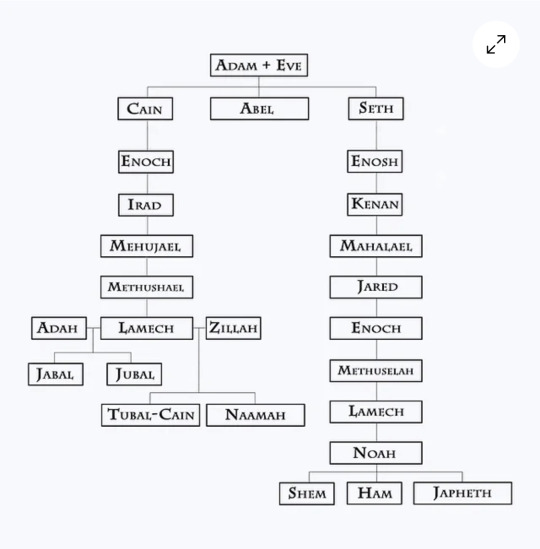
While in the lore of Vampire the Masquerade the tale of Cain killing his brother able as told in the Book of Nod stick to the original tale regarding the murder of Able but starts to differ in God’s punishment. "Father" cursed him with a mark, and cast him out to wander in darkness in the Land of Nod alone. There is no mention of a wife or if he was still cursed to be unable to farm however it is clear that Cain was not yet cursed to be a vampire by God. The Land of Nod was a place of utter darkness, with no source of light, where Caine was afraid and alone. There he found Lilith where they began a relationship and Cain realized that she possessed magical power and begged her to share them with him. While hesitant Lilith prepares an Awakening ceremony by cutting herself with a knife, bleeding into a bowl, and giving it to him so that he may drink. After Caine partakes of Lilith's blood, he is visited by three angels who are agents of God. Each angel offers Caine a chance to repent for the murder of Abel, but Caine rebuffed them out of pride. Michael, when denied, cursed Caine and his childer to fear his living flame. Raphael cursed Caine and his childer to fear the dawn, as the sun's rays would burn like fire. Uriel then cursed Caine and his childer to cling to Darkness, drink only blood, eat only ashes, and be frozen at the point of death, cursed so all they touch would crumble into nothing. A fourth angel, Gabriel, then appeared to offer the way of Golconda, the only way to "light", by the mercy of God. After the experience, Caine becomes officially "Awakened", possessing the following Disciplines: Celerity, Potence, Fortitude, Obfuscate, Dominate, Presence, Protean, Animalism, and Auspex. Caine then became aware of the Path of Blood, the Final Path from which all paths stem. And with all these powers, but now being cursed to be a vampire he breaks his bond with Lilith and leaves her.[3] While Cain never biologically fathers any children it is clear that their names of those he embraced and their decedents are inspired by the biblical names in his line though with massive changes. For instance the first city is founded by Cain in the land of Nod and and called Ubar and is explicitly stated to be settled by “Children of Seth” with the human king being Enoch at the time Cain settles there. Enoch still becomes his son as he is embraced by Cain. Another example of the reuse of a biblical name of Cain’s line is Zillah (which in Hebrew means shade or protection). In the original story she is one of Lamech(decedent of Cain) two wives( the other named Adah). After both wives discover that Lamech unwittingly kills Tubal-Cain(one of Lamech and Zillah’s sons) they both refuse to have sex with him because of the deaths he caused, on the pretext that they do not desire to give birth to cursed offspring. The three go together to the tribunal of Adam; Adam rules that they must obey their husband since he killed unwittingly. This midrashic tradition portrays Adah and Zillah as respected women, whose position is considered in all seriousness by the court. [4] In VTM Zillah was a human woman who lived in Udar so beautiful, Caine could not resist the Embrace. According to Nosferatu Zillah is the one of Cain’s second generation who sired their Antediluvian. Interestingly, even after the Embrace, Zillah did not desire him. It frustrated Caine to the point that he was ripping his hair out of his head. He did anything and everything to make her desire him. Yet, she would not have him. Finally, Caine sought the Crone's magic, who ultimately tricked him into a blood bond, she forced the First Vampire to Embrace her. The Crone sent her new thrall away, telling him that his blood would have the power to bond others as Caine himself was bonded to the Crone. The discovery of the blood bond was what finally made Zillah agree to marry her sire Caine. [3]
[1]“Pietro Novelli .” Wikipedia, Wikimedia Foundation, 14 Nov. 2022, https://en.wikipedia.org/wiki/Pietro_Novelli.
[2]“Baroque Art and Architecture .” Encyclopædia Britannica, Encyclopædia Britannica, Inc., https://www.britannica.com/art/Baroque-art-and-architecture.
[3] “Caine.” White Wolf Wiki, https://whitewolf.fandom.com/wiki/Caine.
[4] Kadari, Tamar. “Zillah: Midrash and Aggadah .” Jewish Women's Archive, https://jwa.org/encyclopedia/article/zillah-midrash-and-aggadah#:~:text=Zillah%20was%20a%20wife%20of,he%20unwittingly%20kills%20Tubal%2DCain.
#VTM#Vampire The Masquerade Bloodlines#VTMB#pietro novelli#cain and abel#baroque art#Explaining one of VTMB paintings#book of nod#Four painting for the price of one
4 notes
·
View notes
Photo

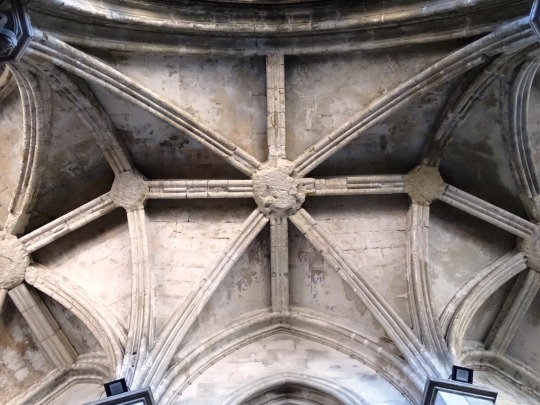
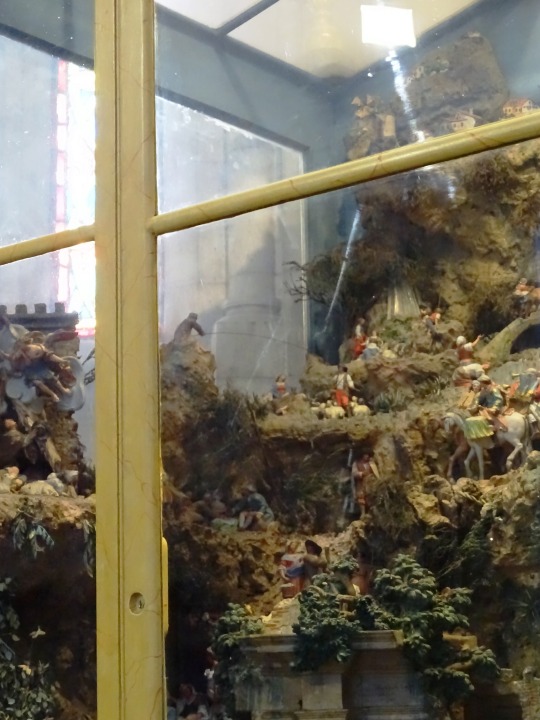
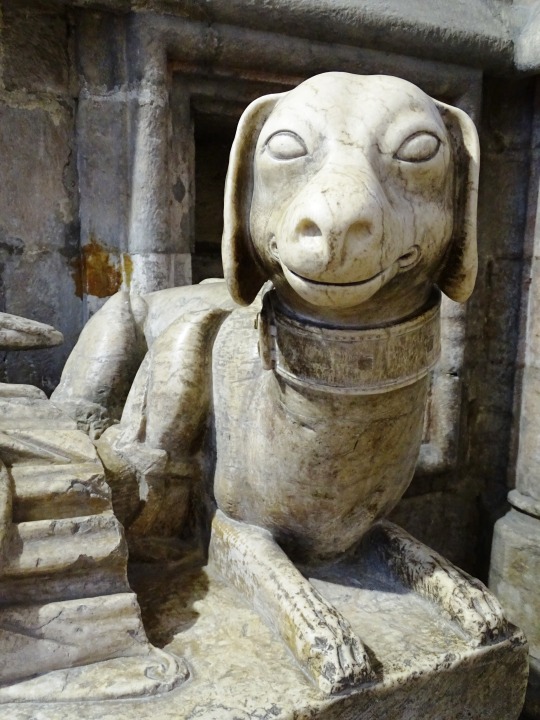


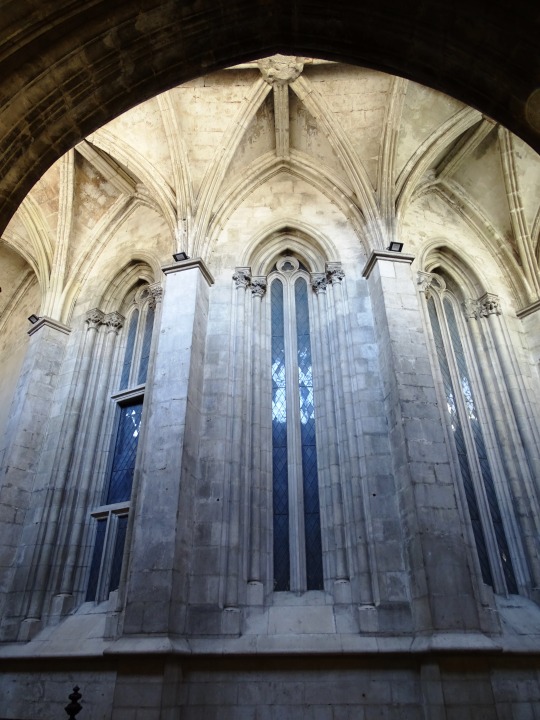
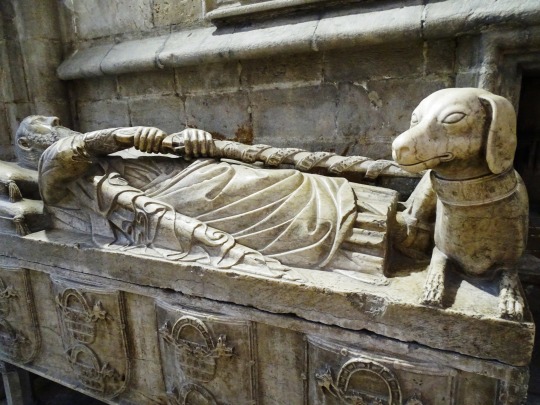

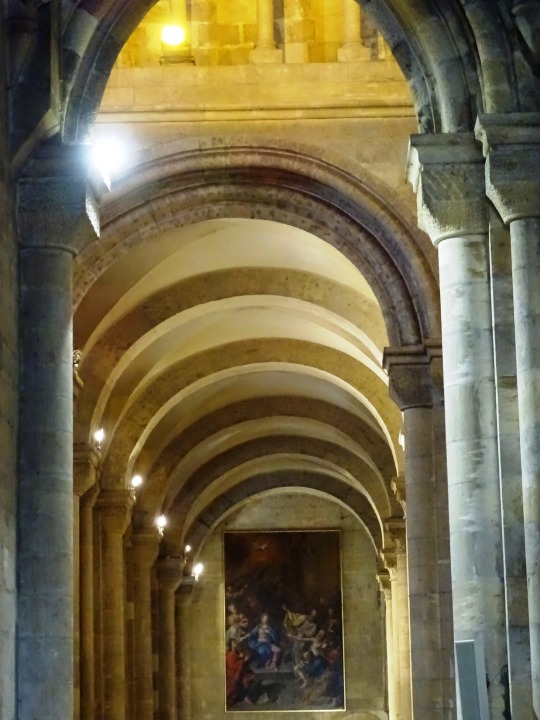
Lisbon Cathedral (No. 7)
The Cathedral of Lisbon, or Church of Santa Maria Maior, is located in the city of the same name, in Portugal. It is the home of the Patriarchate of Lisbon and the Parish of the See. Its construction began in the second half of the 12th century, after the conquest of the city from the Moors by D. Afonso Henriques, and is presented today as a mixture of architectural styles. It has been classified as a National Monument since 1910.
Lisbon has been the site of a bishopric since at least the 4th century, at the end of antiquity. It is also known of the existence of several bishops of the city during the Visigothic period, between the 5th and 7th centuries and In the early 8th century, Lisbon was conquered by the Moors, but the Christian population remained in and around the city. In 1147, when D. Afonso Henriques took the city from the Moors, Lisbon had a Moçarabic bishop (as christians who lived under Muslim rule were called). After the reconquest of the city by King Portuguese and the knights taking part in the Second Crusade, an English crusader, Gilberto de Hastings, was made bishop. Construction of the cathedral began, apparently on the site of lisbon's old mosque. At the same time, Afonso Henriques brought from the Algarve the relics of Saint Vincent de Zaragoza and deposited them in the See.
Source: Wikipedia
#Lopo Fernandes Pacheco#Cathedral of Saint Mary Major#Lisboa#Lisbon#Santa Maria Maior de Lisboa#Metropolitan Cathedral of St. Mary Major#travel#Sé de Lisboa#interior#Chapel of Santo Ildefonso#Joaquim Machado de Castro#Portugal#Southern Europe#summer 2021#original photography#tourist attraction#landmark#tomb#sarcophagus#architecture#cityscape#window#painting
4 notes
·
View notes
Text
The Maldives has a rich and complex history that spans over 2,000 years. The island nation's history includes influences from various cultures, religions, and colonial powers. Here's a detailed timeline of key events in Maldivian history:
### **Ancient History**
- **500 BCE - Early Settlers**: The first inhabitants of the Maldives are believed to have been Dravidian people from southern India and Sri Lanka, who arrived around 500 BCE. They practiced an ancient form of Hinduism and Buddhism.
- **300 BCE - Theravada Buddhism**: By this time, Buddhism began to spread throughout the Maldives, significantly influencing its art, architecture, and culture. Many Buddhist relics and stupas have been found on the islands.
### **Medieval Period**
- **1153 CE - Conversion to Islam**: This is a key moment in Maldivian history. The last Buddhist king, Dhovemi, converted to Islam under the guidance of a North African scholar named Abu al-Barakat. The Maldives became a Sultanate, and Islam has remained the dominant religion ever since.
- **12th - 16th Century - Sultanate Period**: For several centuries, the Maldives was ruled by various sultans. The kingdom was an important trading hub in the Indian Ocean, dealing in cowry shells (used as currency), coconut products, and other goods.
- **1558 - Portuguese Invasion**: The Portuguese briefly occupied the Maldives, but their rule was unpopular. They attempted to convert the Maldivians to Christianity, leading to resistance from the local population.
### **Colonial Era**
- **1573 - Liberation from the Portuguese**: Mohamed Thakurufaanu, a national hero, led a successful revolt against the Portuguese and re-established Maldivian independence. He became the Sultan and ruled until his death in 1585.
- **17th - 19th Century - Dutch and British Influence**: The Maldives fell under the sphere of influence of the Dutch in Ceylon (Sri Lanka) in the 17th century. In 1796, the British took control of Ceylon and, with it, gained influence over the Maldives.
- **1887 - British Protectorate**: The Maldives became a British protectorate in 1887. The British allowed the Maldivians to retain their internal sovereignty while overseeing foreign relations and defense.
### **20th Century**
- **1932 - First Constitution**: The Maldives adopted its first constitution in 1932, introducing a constitutional monarchy. However, political turmoil followed, and Sultan Hassan Nooraddeen was deposed in 1934.
- **1953 - Short-lived Republic**: The first attempt to establish a republic occurred in 1953, but the monarchy was restored after less than a year. Sultan Muhammad Fareed Didi became the head of state.
- **1965 - Independence**: On July 26, 1965, the Maldives gained full independence from Britain, ending its status as a protectorate. The Sultanate continued under King Muhammad Fareed Didi.
- **1968 - Republic Established**: In a national referendum, the monarchy was abolished, and the Maldives became a republic. Ibrahim Nasir became the first President of the Second Republic.
### **Modern Era**
- **1978 - Maumoon Abdul Gayoom's Rule**: Maumoon Abdul Gayoom became president in 1978 and ruled the Maldives for 30 years. His era saw modernization efforts but also accusations of authoritarianism and human rights abuses.
- **2004 - Tsunami**: A devastating tsunami struck the Maldives, causing widespread destruction and loss of life. The disaster underscored the vulnerability of the low-lying island nation to environmental threats.
- **2008 - Democratic Reforms**: In 2008, the Maldives held its first multi-party elections, and Mohamed Nasheed became the first democratically elected president. His government focused on human rights and climate change issues.
- **2012 - Political Turmoil**: Nasheed resigned in 2012 amid protests and a police mutiny, which he later described as a coup. Vice President Mohammed Waheed Hassan took over as president.
- **2013 - Abdulla Yameen's Presidency**: Abdulla Yameen, the half-brother of former President Gayoom, won the 2013 presidential election. His administration faced criticism for curbing freedoms and consolidating power.
- **2018 - Return to Democracy**: In the 2018 elections, Ibrahim Mohamed Solih defeated Yameen, marking a return to democratic governance. Solih's government has since focused on rebuilding international relations and addressing climate change.
### **21st Century Challenges**
- **Climate Change**: The Maldives is one of the most vulnerable countries in the world to the effects of climate change, particularly rising sea levels. The government has been active in international efforts to combat global warming.
The Maldives' history reflects a blend of ancient traditions, colonial encounters, and modern political changes. The country continues to navigate the challenges of its unique geography and political landscape.
0 notes
Text
Underrated Summer Travel Ideas: Discover Hidden Gems Around the World
When it comes to summer travel, popular destinations like Paris, Bali, or the Caribbean often come to mind. But what about those hidden gems that offer unique experiences without the crowds? This year, why not try something different? Here’s a list of underrated summer travel ideas that promise adventure, culture, and relaxation — all in off-the-beaten-path locations.
1. Georgia — The Jewel of the Caucasus
Tucked between Europe and Asia, Georgia is a country that offers a stunning mix of landscapes, from snow-capped mountains to rolling vineyards. During summer, the weather is perfect for hiking in the Caucasus Mountains, exploring ancient monasteries, or enjoying Tbilisi’s vibrant arts scene. Don’t miss the chance to taste Georgian wine — some of the world’s oldest!
2. Faroe Islands — Nature’s Best-Kept Secret
Located between Iceland and Norway, the Faroe Islands are an archipelago known for their dramatic cliffs, cascading waterfalls, and rugged coastlines. With fewer tourists compared to Iceland, the Faroe Islands offer a tranquil experience for nature lovers. Summer is the ideal time to hike, bird-watch, or simply soak in the serene beauty of the fjords.
3. Ljubljana, Slovenia — Europe’s Green Capital
Often overshadowed by its more famous neighbors, Slovenia’s capital, Ljubljana, is a charming, eco-friendly city with a rich history and vibrant culture. Stroll along the Ljubljanica River, explore the medieval Ljubljana Castle, or relax in Tivoli Park. With its lively outdoor cafes and summer festivals, Ljubljana is perfect for those who love a blend of culture and relaxation.
4. Salento, Italy — Beyond the Amalfi Coast
Italy is famous for its well-trodden tourist spots, but the region of Salento, in the southernmost part of Puglia, offers a more laid-back alternative. Think crystal-clear waters, white sandy beaches, and charming towns like Lecce, known as the “Florence of the South.” The region is also known for its delicious seafood and rustic countryside.
5. Svaneti, Georgia — A Hidden Mountain Paradise
For adventure seekers, Svaneti in Georgia is a hidden gem waiting to be explored. Nestled in the Caucasus Mountains, this remote region offers stunning hiking trails, medieval stone towers, and breathtaking scenery. The summer months are perfect for trekking, mountain biking, and exploring the traditional villages scattered across the region.
6. Isle of Skye, Scotland — Mystical Landscapes and Cozy Hideaways
Scotland’s Isle of Skye is renowned for its rugged landscapes, misty mountains, and dramatic cliffs. While Scotland might not be the first place you think of for a summer vacation, Skye’s mild summer weather is ideal for hiking the Quiraing, exploring the Fairy Pools, or visiting the iconic Eilean Donan Castle. The island’s cozy inns and local pubs add a warm touch to the adventure.
7. Kanazawa, Japan — The Lesser-Known Cultural Hub
While Kyoto and Tokyo steal most of the spotlight, Kanazawa is an underrated gem that offers a glimpse into traditional Japan without the crowds. Known for its well-preserved Edo-period districts, samurai houses, and beautiful Kenroku-en Garden, Kanazawa is perfect for a cultural summer trip. Don’t forget to try the local seafood, especially the fresh sushi at Omicho Market.
8. Gdansk, Poland — Baltic Beauty
Gdansk, located on Poland’s Baltic coast, is a city rich in history, culture, and architectural beauty. With its picturesque Old Town, maritime museums, and proximity to sandy beaches, Gdansk is an ideal summer destination. Enjoy a leisurely stroll along the Motlawa River, visit the historic Westerplatte, or relax at the nearby resort town of Sopot.
9. Cape Verde — Africa’s Tropical Oasis
For those looking for a tropical getaway, Cape Verde, an archipelago off the northwest coast of Africa, offers beautiful beaches, crystal-clear waters, and a unique blend of African and Portuguese cultures. Whether it’s hiking the volcanic landscapes of Fogo Island or lounging on the serene beaches of Boa Vista, Cape Verde provides a relaxing and exotic summer escape.
10. Kotor, Montenegro — Adriatic Beauty Without the Crowds
Kotor is a charming coastal town located in Montenegro, surrounded by stunning fjords and mountain scenery. Unlike the crowded cities of Dubrovnik or Split in neighboring Croatia, Kotor offers a more peaceful Adriatic experience. Explore the medieval Old Town, hike up to the Kotor Fortress, or take a boat trip to the Blue Cave.
11. Matera, Italy — The City of Caves
Matera, located in the Basilicata region of Italy, is one of the world’s oldest continuously inhabited cities. Known for its “sassi” (cave dwellings), Matera offers a unique and off-the-beaten-path experience. Wander through the ancient cave churches, enjoy the local cuisine, and take in the views from the Murgia National Park.
12. Valletta, Malta — Mediterranean Magic
Valletta, Malta’s capital, is a UNESCO World Heritage Site with a rich history, stunning architecture, and a vibrant cultural scene. The city offers beautiful views of the Mediterranean, bustling markets, and a variety of summer festivals. Enjoy a boat trip to the Blue Lagoon or explore the historic streets of this underrated summer gem.
13. Guatemala — Central America’s Hidden Treasure
While Costa Rica and Mexico attract much of the attention in Central America, Guatemala offers equally stunning natural beauty and rich cultural experiences. From exploring the ancient Mayan ruins of Tikal to relaxing on the shores of Lake Atitlán, Guatemala is perfect for a unique summer adventure.
14. Alentejo, Portugal — Tranquil Countryside Retreat
Portugal’s Alentejo region is a hidden gem known for its rolling vineyards, medieval towns, and serene beaches. Unlike the crowded Algarve, Alentejo offers a more relaxed pace with plenty of opportunities for wine tasting, exploring ancient castles, and enjoying the unspoiled beauty of the Atlantic coast.
15. Bhutan — The Land of the Thunder Dragon
For a truly unique and off-the-grid summer destination, consider Bhutan, a small Himalayan kingdom known for its stunning landscapes, Buddhist monasteries, and commitment to Gross National Happiness. Summer is a great time to explore Bhutan’s lush valleys, trek to the famous Tiger’s Nest Monastery, and immerse yourself in the country’s rich culture.
Conclusion
While popular summer destinations have their appeal, there’s something uniquely rewarding about exploring lesser-known places. These underrated travel ideas offer not only stunning landscapes and rich cultural experiences but also the joy of discovering hidden gems. So, this summer, dare to venture off the beaten path — you might just find your new favorite destination.
Best Regards
With Itinerary Plans
0 notes
Text
Exploring Cochin with Car Rentals Kerala: Your Ultimate Car Rental Guide
Cochin, also known as Kochi, is a vibrant city in Kerala that blends history, culture, and modernity seamlessly. Whether you're a local looking to navigate the bustling streets or a tourist eager to explore its diverse attractions, having the right transportation is essential. This is where Cochin Car Rental by Car Rentals Kerala steps in, offering a hassle-free way to experience the city at your own pace. Let's delve into what makes renting a car in Cochin with Car Rentals Kerala the perfect choice for your travel needs.
Why Choose Car Rentals Kerala for Your Cochin Adventure?
**1. **Wide Range of Vehicles: ** Whether you're traveling solo, with family, or on a business trip, Car Rentals Kerala provides a diverse fleet of well-maintained vehicles to suit every need. From economical compact cars for city explorations to spacious SUVs for scenic drives and luxurious options for special occasions, there's a car to match your preferences and requirements.
**2. ** Convenient Booking: ** You can easily book your car rental through the Car Rentals Kerala website or by contacting their dedicated customer service team. The booking process is user-friendly, allowing you to select your vehicle, choose your rental duration, and finalize your reservation with just a few clicks. This flexibility makes planning your trip to Cochin seamless and stress-free.
**3. ** Transparent Pricing: ** At Car Rentals Kerala, transparency is key. They offer competitive pricing with no hidden fees, ensuring that you know exactly what you're paying for upfront. This commitment to transparency extends to their rental terms and conditions, giving you peace of mind throughout your journey.
**4. ** Excellent Customer Service: ** Customer satisfaction is a top priority at Car Rentals Kerala. Their knowledgeable and courteous team is available to assist you at every step of the rental process, from booking your vehicle to addressing any queries or concerns you may have during your rental period. This dedication to service ensures a smooth and enjoyable experience for every customer.
**5. ** Safety and Maintenance: ** Your safety is paramount. Car Rentals Kerala adheres to rigorous safety standards and conducts regular maintenance checks on all their vehicles. This commitment ensures that you can explore Cochin with confidence, knowing that your rental car is in optimal condition.
Discovering Cochin: Must-Visit Destinations
Once you've secured your rental car from Car Rentals Kerala, it's time to explore all that Cochin has to offer. Here are some highlights to include in your itinerary:
Fort Kochi: Explore the historic Fort Kochi area with its colonial architecture, art galleries, and the iconic Chinese fishing nets.
Mattancherry Palace: Visit this Portuguese palace known for its stunning murals depicting Hindu mythological themes.
Jew Town: Wander through the narrow streets lined with antique shops, spice markets, and the 16th-century Paradesi Synagogue.
Marine Drive: Take a leisurely drive along this picturesque promenade overlooking the Arabian Sea, especially beautiful during sunset.
Kerala Kathakali Centre: Immerse yourself in Kerala's traditional art forms with a Kathakali dance performance at this cultural center.
Embrace the Freedom to Explore
With Cochin Car Rental by Car Rentals Kerala, you have the freedom to create your own travel itinerary, explore hidden gems, and immerse yourself in the rich cultural tapestry of Cochin. Whether you're visiting for business or pleasure, renting a car provides flexibility, convenience, and an authentic way to experience everything this enchanting city has to offer.
Ready to embark on your Cochin adventure? Book your car rental with Car Rentals Kerala today and unlock the gateway to unforgettable experiences in God's Own Country.
#Cochin Car Rental#Self drive car rental#Rent a car in Trivandrum#Self Drive Cars in Trivandrum#Car Rental in Kozhikode#self drive car rental Trivandrum
0 notes
Text
Lisbon Chronicles: From Ancient Roots to Modern Marvels

Lisbon, the capital city of Portugal, is a captivating blend of rich history, vibrant culture, and breathtaking landscapes. Nestled on the western coast of the Iberian Peninsula, Lisbon has long been a hub of exploration, trade, and cultural exchange. This article delves into the fascinating history of Lisbon, highlights its must-visit places, and provides insights on the best time to explore this enchanting city.
The History of Lisbon
Lisbon's history is a tapestry woven with diverse influences and remarkable events. The city's origins can be traced back to the Phoenicians around 1200 BCE, who established a settlement called "Alis Ubbo." Over the centuries, Lisbon was inhabited by various civilizations, including the Romans, Visigoths, and Moors, each leaving an indelible mark on the city's culture and architecture.
Roman and Moorish Eras
During the Roman era, Lisbon, known as Olissipo, flourished as a significant trading post. The Romans constructed roads, bridges, and aqueducts, some of which still stand today. The fall of the Roman Empire saw Lisbon transition into the hands of the Visigoths and later the Moors. The Moors, who ruled from the 8th to the 12th century, infused the city with Islamic culture, architecture, and advancements in agriculture and science. The Alfama district, with its narrow winding streets and Moorish influences, remains a testament to this period.
The Age of Discovery
The 15th and 16th centuries marked Lisbon's golden age during the Age of Discovery. Under the leadership of Prince Henry the Navigator, Portuguese explorers set sail from Lisbon, embarking on voyages that would change the world. Vasco da Gama's discovery of the sea route to India in 1498 and subsequent expeditions established Lisbon as a global maritime power. The wealth and knowledge brought back by these explorers fueled the Renaissance in Portugal, leading to significant advancements in art, science, and architecture.
Earthquake and Reconstruction
The devastating earthquake of 1755, followed by a tsunami and fires, razed much of Lisbon to the ground. The Marquis of Pombal spearheaded the city's reconstruction, implementing innovative urban planning and architectural techniques. The Baixa district, with its grid-like streets and neoclassical buildings, emerged from this reconstruction, symbolizing Lisbon's resilience and rebirth.

Places to Explore in Lisbon
Lisbon is a city that begs to be explored, with its historic neighborhoods, iconic landmarks, and cultural gems offering a rich tapestry of experiences for visitors.
Alfama: The Alfama district is the oldest neighborhood in Lisbon, characterized by its labyrinthine streets, traditional Fado music, and stunning viewpoints. Visitors can wander through its narrow alleys, visit the São Jorge Castle, and enjoy the panoramic views from Miradouro da Graça.

Belém: Belém is synonymous with Portugal's Age of Discovery. This district is home to the iconic Belém Tower, a UNESCO World Heritage site, and the Jerónimos Monastery, a masterpiece of Manueline architecture. The Monument to the Discoveries, located along the Tagus River, pays tribute to the explorers who set sail from Lisbon.

Baixa and Chiado: Baixa and Chiado are bustling districts in the heart of Lisbon. Baixa is known for its elegant squares, such as Praça do Comércio and Rossio Square, as well as the Elevador de Santa Justa, a stunning neo-Gothic elevator offering panoramic views of the city. Chiado, on the other hand, is a cultural and commercial hub, with its theaters, bookstores, and vibrant cafés.
Bairro Alto: Bairro Alto is Lisbon's bohemian quarter, famous for its lively nightlife and artistic atmosphere. As the sun sets, the neighborhood comes alive with Fado music, trendy bars, and restaurants serving traditional Portuguese cuisine. During the day, visitors can explore its unique shops and historic buildings.
LX Factory: LX Factory, a former industrial complex, has been transformed into a creative and cultural hub. Located in the Alcântara district, it features trendy shops, art galleries, restaurants, and a lively atmosphere. The iconic Ler Devagar bookstore, with its towering bookshelves and whimsical décor, is a must-visit.
Best Time to Visit Lisbon
Lisbon's Mediterranean climate makes it an attractive destination year-round, but the best time to visit depends on your preferences and interests.
Spring (March to May): Spring is one of the best times to visit Lisbon, as the weather is mild and the city is in full bloom. The temperatures range from 15°C to 20°C (59°F to 68°F), making it perfect for exploring the city's outdoor attractions. Additionally, the spring months see fewer tourists compared to the summer, providing a more relaxed experience.
Summer (June to August): Summer in Lisbon is warm and bustling with activity. Temperatures can soar to 30°C (86°F) or higher, making it ideal for enjoying the city's beaches and outdoor festivals. However, this is also the peak tourist season, so expect larger crowds and higher prices for accommodation and attractions.
Autumn (September to November): Autumn is another excellent time to visit Lisbon, with pleasant temperatures ranging from 15°C to 25°C (59°F to 77°F). The summer crowds begin to thin out, and the city's parks and gardens are adorned with vibrant fall colors. September, in particular, is a great month to experience the city's cultural events and festivals.
Winter (December to February): Winter in Lisbon is mild compared to other European cities, with temperatures rarely dropping below 8°C (46°F). While there may be occasional rain, the city remains lively with Christmas markets, festive lights, and cultural events. Winter is also the off-peak season, offering more affordable accommodation options.
Conclusion
Lisbon is a city that seamlessly blends its rich historical heritage with contemporary culture and vibrant energy. From its ancient neighborhoods and iconic landmarks to its creative hubs and lively districts, Lisbon offers a diverse range of experiences for every traveler. Whether you're exploring the narrow streets of Alfama, marveling at the architectural wonders of Belém, or enjoying the nightlife in Bairro Alto, Lisbon promises a journey filled with discovery and enchantment. Additionally, check holidays in Portugal prior to travel to improve your overall tour experience. So, pack your bags and set out to explore this captivating city, where the past and present converge in a harmonious symphony of culture, history, and adventure.
1 note
·
View note
Text
Self-Drive Car Rentals in Kochi: Your Ultimate Guide
Kochi, also known as Cochin, is a bustling port city in Kerala, renowned for its rich history, stunning landscapes, and vibrant culture. Whether you’re a tourist looking to explore the city at your own pace or a local in need of a temporary vehicle, self-drive car rentals offer the perfect solution. Here’s everything you need to know about self-drive car rentals in Kochi.
Benefits of Self-Drive Car Rentals
Flexibility and Freedom: Self-drive car rentals give you the freedom to explore Kochi at your own pace without relying on public transport or taxi services.
Privacy: Enjoy the privacy of having your own vehicle, which is particularly beneficial for family trips or romantic getaways.
Cost-Effective: Often more cost-effective than hiring a chauffeur-driven car, especially for longer durations.
Variety of Choices: A wide range of vehicles to choose from, including compact cars, sedans, SUVs, and luxury cars, catering to different needs and preferences.
Popular Self-Drive Car Rental Options in Kochi
Kochi boasts several reputable self-drive car rental services offering a diverse fleet of vehicles. Here are some options to consider:
Economy Cars: Ideal for budget-conscious travelers looking for efficient and affordable transportation.
Sedans: Perfect for business travelers or small families needing extra comfort and space.
SUVs: Suitable for larger groups or those planning to explore rugged terrains.
Luxury Cars: For those who want to travel in style and enjoy high-end features and performance.
How to Choose the Right Self-Drive Car Rental Service
Compare Prices: Research different rental services and compare prices to find the best deal. Look out for discounts and special offers.
Check Vehicle Condition: Ensure the car is well-maintained and in good condition to avoid any breakdowns or issues during your rental period.
Read Reviews: Customer reviews and ratings can provide insights into the reliability and quality of the rental service.
Verify Documentation: Ensure you have all the necessary documents, including a valid driver’s license, identification proof, and the rental agreement.
Understand the Terms: Carefully read the rental agreement, paying attention to terms related to mileage limits, fuel policy, insurance coverage, and additional charges.
Tips for a Smooth Rental Experience
Book in Advance: To secure your preferred vehicle, especially during peak tourist seasons, it’s advisable to book your rental car in advance.
Inspect the Car: Before driving off, inspect the car for any pre-existing damages and ensure all features are functioning properly. Document any issues to avoid disputes later.
Know the Routes: Familiarize yourself with Kochi’s roads and traffic rules. Planning your routes in advance can save time and help you avoid getting lost.
Emergency Contacts: Keep the rental company’s emergency contact information handy in case you encounter any issues during your rental period.
Top Attractions to Explore with Your Self-Drive Rental in Kochi
With a self-drive rental car, you can conveniently explore Kochi’s top attractions, including:
Fort Kochi: Known for its colonial architecture, quaint streets, and the iconic Chinese fishing nets.
Mattancherry Palace: A Portuguese palace showcasing beautiful murals and artifacts.
Marine Drive: A picturesque promenade perfect for a leisurely drive.
Hill Palace Museum: Kerala’s largest archaeological museum offering a glimpse into the region’s royal history.
Cherai Beach: A serene beach ideal for a relaxing day trip.
Conclusion
Self-drive car rentals in Kochi offer a convenient, flexible, and cost-effective way to explore the city and its surroundings. By choosing the right rental service and following the tips provided, you can ensure a smooth and enjoyable travel experience. Whether you’re here for business or leisure, a self-drive car gives you the freedom to discover Kochi on your own terms.
Ready to hit the road and explore Kochi? Contact one of the many self-drive car rental services available and start your adventure today!
#Car rental#india#kerala#Luxury Car Rental Companies in Kerala#premium cars for rent in trivandrum#self drive car rentals in kochi#self drive car rentals in trivandrum @lowest price#travel#Travel tips
0 notes
Text
Exploring the Rich Heritage of the Museum of Christian Art in Goa

Introduction to the Museum of Christian Art
The Museum of Christian Art, located in Goa, is a unique repository of Indo-Portuguese Christian artifacts. Situated within the Convent of Santa Monica in Old Goa, the museum offers a profound glimpse into the rich cultural and religious history that marks the region. The collection is a testament to the centuries-old blend of Indian and European art forms, showcasing the deep-rooted influence of Christianity in Goan culture.
The Museum of Christian Art is a place where you can discover the hidden legacy of Goa. If you’re an art fanatic then this place is all yours to explore. It is one of the finest places to visit in Goa.
Historical Significance of the Museum

The Birth of the Museum
Established in 1994, the Museum of Christian Art was initiated to preserve and promote the unique Christian art heritage of Goa. The museum's inception was driven by the need to protect the invaluable artifacts that were rapidly deteriorating due to neglect. This initiative was supported by the Calouste Gulbenkian Foundation of Portugal and the Indian National Trust for Art and Cultural Heritage (INTACH).
The Convent of Santa Monica
The museum is housed in the historical Convent of Santa Monica, an architectural marvel built in the early 17th century. This convent, one of the oldest and largest of its kind in Asia, adds a layer of historical depth to the museum. The structure itself is an example of Indo-Portuguese architecture, with its majestic arches, high ceilings, and intricate designs.
Key Exhibits and Collections

Ecclesiastical Artifacts
The museum's collection primarily consists of ecclesiastical artifacts from the 16th to the 20th centuries. These artifacts reflect the confluence of European and Indian artistic traditions. Some of the key exhibits include:
Altarpieces: Exquisitely carved wooden altarpieces that exhibit a blend of Gothic and Baroque styles.
Statues and Sculptures: Statues of saints and religious figures, often carved from ivory and wood, depicting fine craftsmanship.
Paintings: Oil paintings and murals illustrating biblical scenes, often created by Goan and European artists.
Liturgical Objects
A significant portion of the museum's collection comprises liturgical objects used in Christian worship. These include:
Chalices and Ciboriums: Made from precious metals and adorned with intricate designs.
Vestments: Ornate vestments embroidered with gold and silver threads, used by priests during mass.
Processional Crosses: Large crosses carried during religious processions, showcasing a mix of Indian and Portuguese influences.
Furniture and Decorative Arts
The museum also boasts an impressive array of furniture and decorative arts, reflecting the lifestyle and religious practices of the period. Noteworthy items include:
Church Furniture: Elaborately carved wooden pews, confessionals, and pulpits.
Decorative Items: Items such as candle stands, monstrances, and reliquaries, often gilded and embellished with precious stones.
Educational and Cultural Impact

Preservation and Restoration Efforts
The museum plays a crucial role in the preservation and restoration of Christian art in Goa. It conducts regular workshops and training sessions on conservation techniques, ensuring that the artifacts are preserved for future generations. The museum collaborates with international experts to maintain high standards of restoration.
Cultural Programs and Outreach
The Museum of Christian Art is not just a repository of artifacts; it is also a vibrant cultural center. The museum organizes various cultural programs, including:
Art Exhibitions: Temporary exhibitions that highlight different aspects of Christian art and heritage.
Lectures and Seminars: Educational events featuring historians, theologians, and art experts.
Workshops: Hands-on workshops on traditional art forms, painting, and sculpture.
Visiting the Museum
Location and Accessibility
The Museum of Christian Art is located within the Convent of Santa Monica, in Old Goa. The site is easily accessible by road, with ample parking facilities for visitors. The museum is open from Tuesday to Sunday, with guided tours available upon request.
Visitor Experience
A visit to the Museum of Christian Art offers a deeply enriching experience. The museum provides detailed descriptions and context for each exhibit, enhancing visitors' understanding of the artifacts. Audio guides and interactive displays are also available to offer a more engaging experience.
0 notes
Text
Classical Music 101: The Baroque Era
Welcome back to our series, Classical Music 101! Our goal with this series is to provide an approachable, non-intimidating introduction to classical music so you can start appreciating this timeless musical genre.
In our last article, we looked at the origins of classical music, beginning with the ancient Greeks and ending with the Renaissance. Western art/concert music, what we now popularly call classical music, began with simple monophonic chanting and developed more complexity with the introduction of polyphony as time progressed. A primary feature of early Western music was that it was voice-based — instruments were used sparingly. It wasn’t until the end of the Renaissance that Western music began shifting to become predominated by instruments.
In today’s article, we’ll take a musical tour of the Baroque era. Put on your powdered wig, and let’s get going.
The Baroque Era (1600-1750)
The Baroque era began roughly around 1600 with the composition of the first opera and lasted until the death of Johann Sebastian Bach in 1750.
The word “baroque” comes from Portuguese and means “irregular pearl.” It was originally used to unflatteringly describe the art, architecture, and music produced in the 17th and 18th centuries. Early critics thought the art, music, and architecture of the 1600s and early 1700s were too ornate and too flamboyant. But with time, “baroque” lost its reproachful meaning.
Baroque music is big, elaborate, intricate, and emotional while being governed by logic and order. The logic and order of Baroque music laid the foundation for musical notation and theory that we still use today.
It was also during the Baroque period that Western music began to be primarily instrumental. The harpsichord was a favorite instrument of Baroque composers. If you hear a classical piece with a harpsichord, chances are it’s from the Baroque era.
A funny aside about harpsichords: Conductor Sir Thomas Beecham, who wasn’t a fan of the instrument, once compared the sound of a harpsichord to “two skeletons copulating on a tin roof in a thunderstorm.” Lol. Sir Beecham has no chill.
What was behind the bigness, the ornateness, and the orderliness of Baroque music? Well, a few things:
First, the Baroque period saw the rise of monarchs with absolute power — think King Louis XIV of France. This centralization of power into a single individual led to a demand for architecture, art, and music that could enhance the prestige of a monarch and their royal courts. Composers were hired to write music that glorified the king and added to his larger-than-life image.
Second, during the Baroque era, you saw significant scientific advances. Newton discovered that laws and mathematics governed the universe. Musicians began to apply this scientific view to their music by writing pieces governed by logic, order, and math.
Third, in response to the Protestant Reformation, the Catholic Church began the Counter-Reformation that saw the embrace of music as a way to win souls. You start to see a shift away from plainchant music in churches towards elaborate, dramatic, highly emotional musical pieces designed to inspire religious awe in the listener.
Characteristics of Baroque Era Music
Counterpoint. Counterpoint is a technique of composing with interdependent yet independent melodic lines. A piece with counterpoint will have two lines of melody that can be played independently, but when put together, form a complex and cohesive piece of music rich in texture. The fugue is a musical form developed during the Baroque era that used counterpoint. Here’s an example of a fugue that showcases counterpoint beautifully. Note how complex and textured it sounds:
Basso continuo. Basso continuo is a continuous bass line that provides a rhythmic backbone for all the variety and complexity in a Baroque piece. Here’s an example of basso continuo (it’s Dutch; the cello and double bass provide the basso continuo):
Rhythmic patterns. Baroque music frequently features a driving rhythm that continues… http://dlvr.it/T7C09P
0 notes
Text
Top 7 Most Visited Monuments in Portugal
Welcome to Portugal, a country steeped in history and culture where every corner tells a story of its rich past. As you embark on your journey through this charming nation, be sure to explore its most visited monuments, each offering a glimpse into Portugal's fascinating heritage. Portugal's most visited monuments include stunning palaces, ancient castles, ornate monasteries, and impressive cathedrals, each reflecting different periods of the country's history and cultural influences. From the Manueline splendor of Belém Tower and Jerónimos Monastery in Lisbon to the fairytale-like Pena Palace nestled in the hills of Sintra, Portugal's monuments captivate visitors with their beauty, grandeur, and historical importance. Whether you're wandering through the medieval streets of Lisbon's Castle of São Jorge, exploring the mysterious Quinta da Regaleira in Sintra, or marvelling at the Gothic splendor of Batalha Monastery, each monument offers a unique and unforgettable experience. Join us as we embark on a journey through Portugal's most visited monuments, uncovering the stories and secrets behind these architectural marvels and immersing ourselves in the country's rich cultural heritage.
Here are some of the most visited monuments in Portugal:
1.Belém Tower: One of Portugal's most recognizable monuments and a UNESCO World Heritage Site is Lisbon's Belém Tower. Constructed during the 16th century, the tower functioned as a stronghold and symbolic entrance to the city. Its exquisite stone sculptures, Manueline architecture, and commanding vistas of the Tagus River are all visible to visitors. Discover the tower's rich history as a representation of Portugal's maritime legacy as you tour its interior chambers and ascend to the top for expansive views.
2. Monastery of Jerónimos: Situated in Lisbon's Belém area, the Jerónimos Monastery is yet another outstanding example of Manueline architecture. Built in the sixteenth century, the monastery is well known for its exquisite internal design, elaborate brickwork, and magnificent cloisters. Discover the church's exquisite stained-glass windows and famous people's tombs, such as those of Vasco da Gama, and marvel at the cloisters' exquisite design while taking in the peaceful ambience of this UNESCO-listed landmark.
3.Pena Palace: Perched on a hill with sweeping views of verdant woodlands, Pena Palace is a castle straight out of a fairy tale situated in the charming town of Sintra. Constructed during the 1800s, the palace exhibits an imaginative fusion of architectural forms, showcasing vivid hues, ornate turrets, and intricate details. Explore the lavish interiors of the palace, take a leisurely stroll around the beautiful gardens filled with exotic plants and statues, and take in expansive views of the surrounding countryside.
4. The São Jorge Castle: Nestled in the center of Lisbon, the historic Castle of São Jorge provides panoramic views of the city and the Tagus River. The castle, which dates to the Moorish era, has long served as a tactical bulwark. From the ramparts of the castle, visitors may stroll around its historic walls, investigate archeological sites, and take in expansive vistas. In addition, a museum featuring information about Lisbon's past and archeological discoveries is located within the castle.
5. Quinta da Regaleira: Quinta da Regaleira is a magnificent house in Sintra that is well-known for its Gothic architecture, enigmatic passageways, and lovely gardens. Constructed in the early 1900s, the estate has an intriguing fusion of art, architecture, and symbolism and is recognized as a UNESCO World Heritage site. Discover the elaborate gardens with their fountains, grottoes, and statues. Then, head down to discover the caverns and tunnels decorated with ethereal designs and symbols.
6. Monastery of Batalha: Batalha Monastery, a UNESCO World Heritage Site, is a magnificent example of Portuguese Gothic architecture and is situated in the town of Batalha. Constructed in the fourteenth century to honour Portugal's triumph against the Castilian army, the monastery is well-known for its magnificent interior, elaborate stone carvings, and stained-glass windows. The nave, chapels, and cloisters are incredibly beautiful, and visitors may also wonder at the tombs of Portugal's kings and queens.
Évora Cathedral
7.Évora Cathedral: Situated in the medieval city of Évora, the Évora Cathedral is a UNESCO World Heritage Site and one of Portugal's most significant religious structures. Constructed throughout the 12th and 14th centuries, the cathedral exhibits a blend of Gothic, Romanesque, and Baroque architectural designs. Explore its interior, which has exquisite altars, chapels, and holy objects, and take in its commanding façade, exquisite carvings, and breathtaking rose window. The rooftop of the cathedral provides expansive views over Évora and the Alentejo area.
Conclusion:
Exploring the most visited monuments in Portugal offers travelers a captivating journey through the country's rich history, culture, and architectural heritage. From the towering ramparts of Belém Tower to the enchanting gardens of Quinta da Regaleira, each monument provides a window into Portugal's past and a testament to its enduring legacy. As you plan your visit to Portugal, obtaining a Portugal visa is a crucial step to ensure a smooth and hassle-free entry into the country. With the necessary documentation in hand, you can explore the iconic landmarks of Lisbon, the fairytale castles of Sintra, and the majestic cathedrals of Porto without any impediment. Whether you're admiring the intricate carvings of Jerónimos Monastery, wandering through the labyrinthine alleys of Évora Cathedral, or soaking in the panoramic views from the Castle of São Jorge, Portugal's monuments promise to leave you spellbound with their beauty and historical significance. Join us as we uncover the stories and secrets behind these remarkable monuments, immersing ourselves in Portugal's vibrant culture and heritage. Whether you're a history buff, an architecture enthusiast, or simply a curious traveller, Portugal's most visited monuments offer a journey through time and a glimpse into the soul of this enchanting country.
0 notes
Text
Portugal Investor Visa
One of Europe’s oldest countries, Portugal boasts a rich historical and architectural heritage. Luminosity, radiance and culture beam through the whitewashed villages and lush vineyards of this country positioned on the blissfully elegant shores of the Atlantic ocean.
INVEST IN PROPERTY
2.6+ CR
SOURCE OF FUND
No
ENGLISH & EDUCATION
No
GENERATION CITIZENSHIP
4
WHY CHOOSE PORTUGAL?
Portugal boasts a rich and diverse culture, Mediterranean climate, and a safe and stable setting ideal for raising families, conducting business or travelling. Investors find many opportunities in Portugal’s secure and fast-developing market, including the following:
Residence visa waiver for entering Portugal.
Live and work in Portugal.
Visa-free travel within the Schengen member states.
Permanent residency or citizenship of Portugal after five years as a temporary resident.
Inclusion of family members, such as spouse or partner, dependent children and dependent parents.
QUALIFICATIONS
Portugal’s Golden Resident Permit Program is offered in accordance with the Ministry of Foreign Affairs through the Department of Consular Affairs and the Portuguese Trade and Investment Agency (AICEP).
Aimed at attracting foreign direct investments to the country, the program yields a residency permit in Portugal to non-EU investors who fulfill one of the investment options below and meet the following requirements:
Provide proof that investment funds originate from abroad.
Hold no criminal record.
The main applicant’s property is not frozen within the boundaries of the EU.
Pay application and processing fees where applicable.
Enter Portugal for the first time on a valid Schengen visa.
Meet or exceed the minimum stay requirements. (Seven days for the first year, 14 days for subsequent two-year periods.)
INVESTMENT OPTIONS
1. Property Investment Options — In July 2015, through Act 63/2015 and Regulatory Decree 15-A/2015, the required investment options were revised and new ones added. Investors can now choose from the following:
Applicants may acquire property valued at €500,000 or more, or
Applicants may acquire property valued at €350,000 or more for properties more than 30 years old or located in urban regeneration areas designated for refurbishing, or
Acquisition of property fitting any of the above requirements with 20% reduction on the minimum amount of investment, if purchased on a low density population area (€400,000.00 or €280,000.00).
Property Selection
Arton handpicks prestigious projects to meet our clients’ expectations. By investing in fractions of pre-qualified projects applicants become co-owners of the entire project and qualify for Portugal’s Golden Visa. Our selected projects share some key benefits:
Guaranteed annual rental return, starting from the first year of operation;
Easy and flexible exit strategy;
100% funds return guarantee after obtaining permanent residency or citizenship;
7 days accommodation per year.
Sé Catedral Hotel (sold out)
Located in the heart of Porto, close to the Douro River, this 50-room hotel rehabilitation consists of 38 fractions at €350,000 each. Request our project brochure.
Caldas de Canavezes Luxury Hotel and Spa (sold out)
Located in a low-density area of the country, facing the Tâmega River, this luxury hotel and spa transformation consists of 45 fractions at €280,000 each. Request our project brochure.
Cascais
Located in the center of Cascais, facing the ocean and Cidadela, this palatial house rehabilitation of a 20-suite boutique hotel consists of 22 fractions at €350,000 each. Request our project brochure.
2. Capital Investment
Applicants may invest a minimum of €350,000 in research activities.
Applicants may invest a minimum of €250,000 in the arts or in the reconstruction or refurbishment of national heritage projects.
Applicants may invest a minimum of €500,000 for shares in investment funds or venture capital.
Applicants must create 10 or more jobs.
0 notes
Text
The Colorful Tapestry of Chinoiserie: Artistic Expression and Cultural Fusion of East-West Influence
During the era of the ancient Roman Empire, Chinese silk was highly esteemed in the West, becoming a precious commodity. Despite knowing little about the origins of silk, the Romans placed great importance on this trade. An anonymous Roman writer in the 1st century AD speculated about the routes to China, which is regarded as one of the earliest descriptions in European literature. He wrote: “The ultimate source of the sea is connected with Thin, a city in the interior of the country, somewhat to the north, known as Thinae. From there, the route is the same, overland to the Great Xiongnu and to Bactria, through which raw silk, silk thread, and woven silk fabrics are brought, just as they are brought through Limyra in Lycia by way of the Ganges.” This description highlights the significance of silk trade at the time and the Western desire for Chinese goods.
In the 14th century, Marco Polo’s travelogue “The Travels of Marco Polo” distilled several generations of European mythical imaginings about the East and played a significant role in the creation of the Chinese style, which depended on an incomplete and romanticized understanding of China. Among all the Europeans who had visited China in the Middle Ages and early modern period, none understood China better than Matteo Ricci, a Portuguese priest who resided in China for over 25 years until his death in Beijing in 1610. He learned Chinese, mastered the intricate etiquette required by the Chinese court, studied Confucianism, and became a disseminator of Confucianism to Europe.
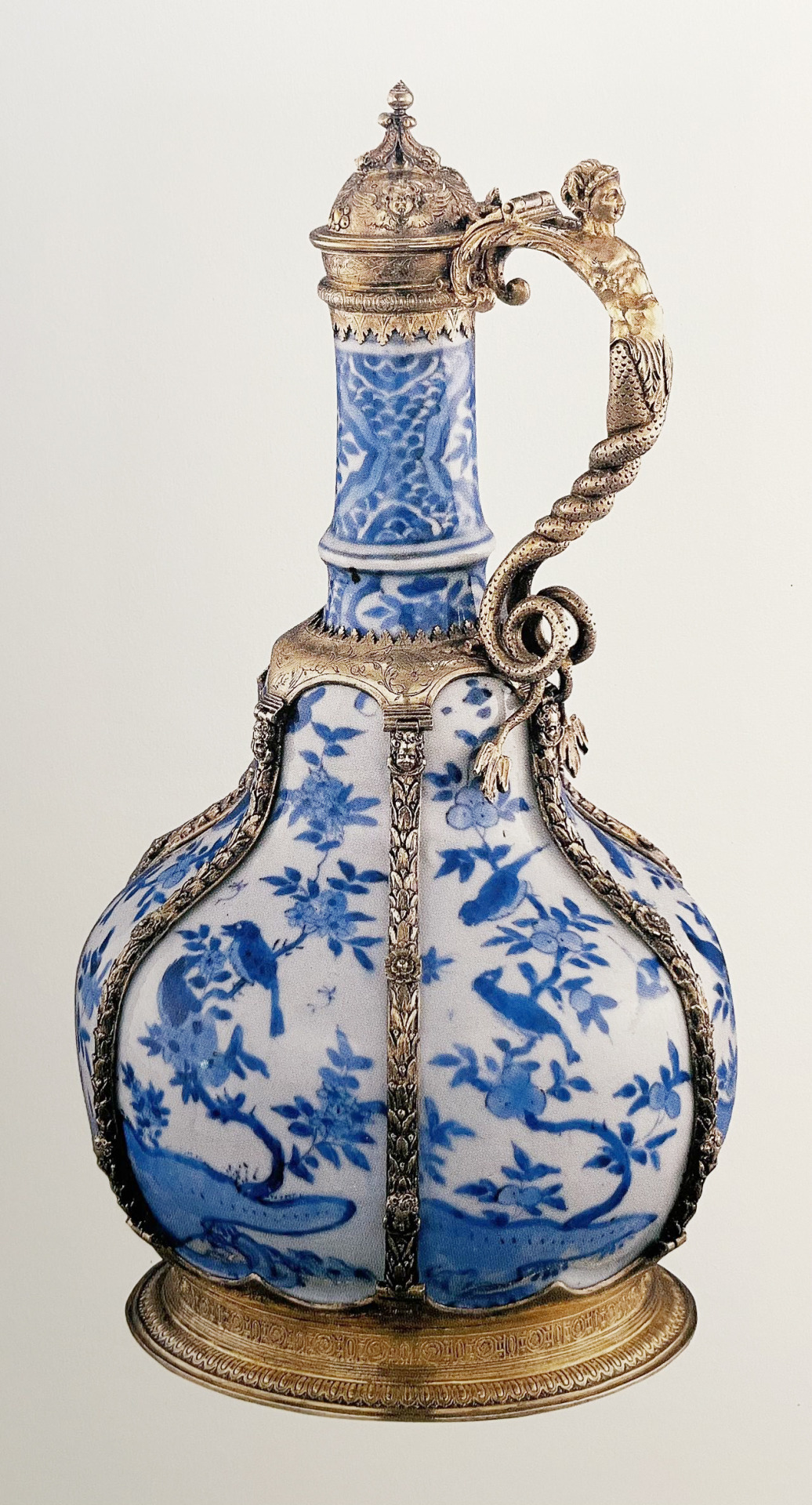
Ming Dynasty blue and white porcelain water jar, adorned with gilded silver mounts from 16th-century England
By 1638, the Dutch had imported over three million pieces of porcelain from China, primarily featuring blue floral motifs on a white background, yet crafted in a range of European-style shapes. This amalgamation of styles exemplifies the characteristics of Chinoiserie. To safeguard the delicate porcelain, European craftsmen often opted to embellish them with gilded mounts, preventing accidental breakage. However, this function-driven approach also evolved aesthetically into a blended form of East-West fusion, which epitomizes the essence and allure of Chinoiserie.
In 16th-century European art, the beauty of the human body was celebrated, advocating that human proportions are the most harmonious in the world and applying them to architecture, sculpture, and decoration. On this piece of Chinoiserie porcelain, the English combined gilded sculptures of half-human, half-divine figures with blue and white porcelain. The figurative forms flow naturally, with dynamic swirling curves, as if pulling divinity towards the mundane, also hinting at the precious status of blue and white porcelain in Europe from another perspective.
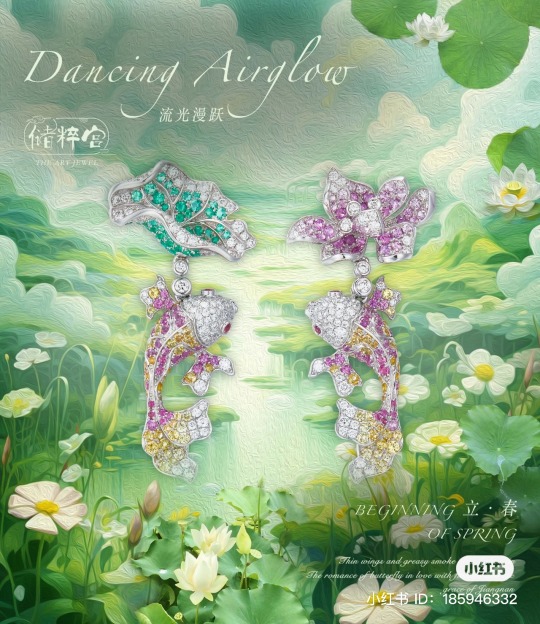
ChuCui Palace Dancing Airglow Earrings
In the mid-20th century, ChuCui Palace pioneered the fusion of Chinoiserie with traditional Chinese brushwork, bringing Eastern painting aesthetics into the realm of jewelry design. This integration created a unique branch of mixed East-West styles. In their work “Dancing Airglow” earrings, ChuCui Palace sculpted a lively pair of plump and leaping koi fish. The piece adopts the naturalistic asymmetry characteristic of Chinoiserie and portrays the unique dynamic beauty with smooth, rounded curves. It captures the vitality of the koi fish, lotus, and leaves.
The most striking aspect of the work is the emulation of the technique of “fen ran” in traditional Chinese brushwork, where inlaying is meticulously applied. The juxtaposition of clear gold and delicate purple transitions naturally, sometimes dense and light, sometimes light and dense, akin to ink blending on paper. It allows one to appreciate that Chinese painting not only embodies subtle ink tones but also employs meticulous color rendering, showcasing another facet of richness, passion, delicacy, and grandeur, which can be equally elegant. Though akin to a small-scale composition, it seamlessly incorporates a genuine attitude towards life, exuding a refined and profound demeanor.
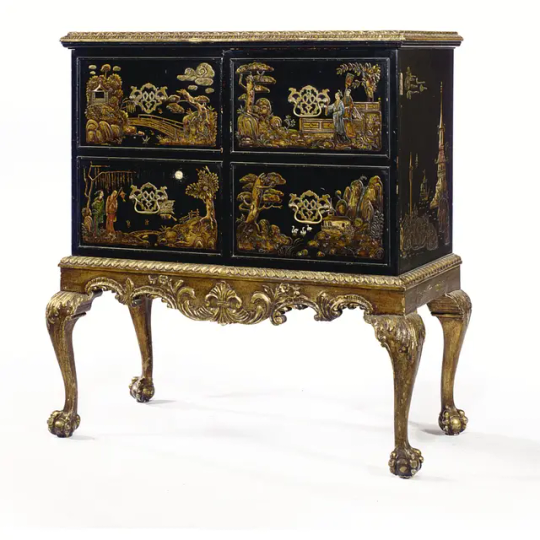
Queen Anne-style Chinoiserie decorations and partially gilt bordered cabinets
In Sotheby’s auction of Chinoiserie furniture, there is a “Queen Anne-style” Chinoiserie decoration and partially gilt bordered cabinet. It vividly illustrates the classic hybrid form within Chinoiserie. With the European “Queen Anne” style exterior, infused with Chinese lacquer craftsmanship and decoration, it differs markedly from the early 17th-century and William and Mary styles. The “Queen Anne” style furniture decoration is greatly simplified compared to the latter, which prominently features marquetry, patterned wood veneers, painting, and carving techniques. The curved legs are the “most representative elements” of Queen Anne furniture, influenced by the designs of French furniture maker André-Charles Boulle and the Louis XV-era French court Rococo style.
While the “Queen Anne” style adopts restrained decoration in its European-inspired design elements, the Chinese patterns feature intricate and delicate depictions of landscapes, architecture, and figures. These motifs are natural in form, presenting a subtle relief effect and embracing the asymmetric compositions typical of Chinoiserie. The piece as a whole eschews grandeur for a lighter, more comfortable silhouette, yet the dramatic effect of Chinoiserie lacquer and gilt retains shadows of the late Baroque period.
Chinoiserie, as a decorative art style, showcases the fusion and collision of Eastern and Western cultures. In its decorative elements, we see both a fascination with and admiration for Chinese art and culture, as well as the imaginative creations of European artists inspired by exoticism. Particularly in the production of porcelain and furniture, Chinoiserie has attracted numerous European nobles and merchants with its unique style and decorations. This hybrid form not only highlights the importance of cultural exchange but also provides a vast space and inspiration for artistic creation. Through Chinoiserie, we not only glimpse the aesthetic tastes and cultural preferences of historical periods but also feel the endless exploration and imagination of artists towards exoticism. As a unique decorative style, Chinoiserie will continue to play an important role in the art world, enriching people’s aesthetic experiences, and promoting the process of cross-cultural exchange and understanding.
0 notes
Text
Here's a list of 20 significant empires in history, along with details about their prominence, achievements, and the period they existed:
1. **Roman Empire (27 BC - AD 476)** - Known for its vast territorial conquests, legal system, engineering marvels, and lasting cultural influence on Western civilization.
2. **Mongol Empire (1206-1368)** - Under Genghis Khan and successors, the Mongols created the largest contiguous empire in history, connecting East and West through trade and conquest.
3. **British Empire (16th century - 20th century)** - A global empire with colonies on every continent, shaping modern geopolitics, trade, and culture.
4. **Ottoman Empire (1299-1922)** - A major Islamic empire, known for its military prowess, cultural achievements, and administrative innovations.
5. **Mughal Empire (1526-1857)** - Ruled much of the Indian subcontinent, known for its art, architecture, and religious tolerance.
6. **Byzantine Empire (330-1453)** - The continuation of the Eastern Roman Empire, with Constantinople as its capital, preserving Greco-Roman culture and Christian heritage.
7. **Persian Empire (550 BC - 330 BC)** - A major power in the ancient world, known for its administrative efficiency, infrastructure, and contributions to art and science.
8. **Russian Empire (1721-1917)** - Extended across Eurasia, expanding Russian influence and establishing a powerful monarchy.
9. **Spanish Empire (15th century - 19th century)** - Dominated the Americas, Europe, and parts of Asia, leading to significant cultural exchanges and economic growth.
10. **French Empire (16th century - 19th century)** - A major European power with colonial holdings, cultural influence, and military achievements.
11. **Chinese Empire (221 BC - 1912 AD)** - Several dynasties, including the Han, Tang, and Qing, ruled vast territories in East Asia, with notable achievements in art, literature, and governance.
12. **Inca Empire (1438-1533)** - Centered in modern-day Peru, the Inca Empire was known for its advanced agricultural techniques, engineering, and administrative systems.
13. **Holy Roman Empire (800-1806)** - A complex union of territories in Central Europe, with a mix of monarchies, republics, and ecclesiastical states.
14. **Achaemenid Empire (550 BC - 330 BC)** - The first Persian Empire, known for its size, organizational structure, and contributions to law and governance.
15. **Aztec Empire (1428-1521)** - Centered in Mexico, the Aztec Empire had a highly structured society, advanced agriculture, and impressive architectural achievements.
16. **Portuguese Empire (15th century - 20th century)** - Explored and colonized territories in Africa, Asia, and the Americas, playing a significant role in global trade and exploration.
17. **Islamic Caliphates (632-1924)** - Successive caliphates, including the Umayyad, Abbasid, and Ottoman, expanded Islamic influence across the Middle East, North Africa, and parts of Europe and Asia.
18. **German Empire (1871-1918)** - Unified under Prussian leadership, the German Empire became a major European power with industrial prowess and military strength.
19. **Egyptian Empire (3100 BC - 332 BC)** - Ancient Egypt, with its pharaohs, pyramids, and advanced civilization, had a lasting impact on art, religion, and culture.
20. **Austro-Hungarian Empire (1867-1918)** - A dual monarchy with significant influence in Central and Eastern Europe, contributing to political and cultural developments in the region.
These empires left enduring legacies in various aspects of human civilization, including politics, economics, culture, and technology, shaping the course of history for centuries to come.

0 notes